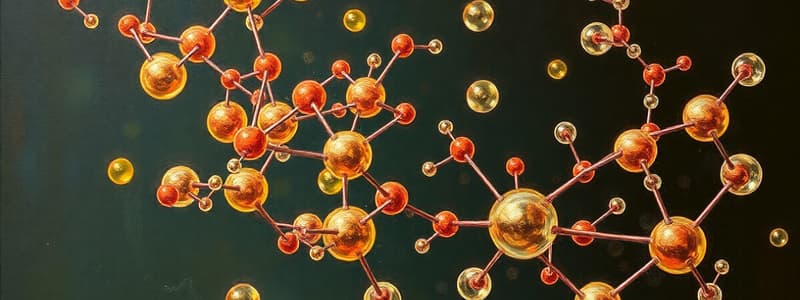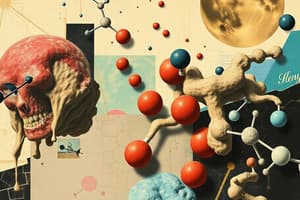Podcast
Questions and Answers
Which biological function is NOT correctly matched with its protein example?
Which biological function is NOT correctly matched with its protein example?
- Storage proteins: Ferritin
- Contractile proteins: Collagen (correct)
- Enzymes: Pepsin
- Hormones: Insulin
What structural feature defines an α-amino acid?
What structural feature defines an α-amino acid?
- A hydroxyl group attached to the beta carbon.
- A sulfur atom in the side chain.
- Aromatic ring attached to the alpha carbon.
- An amino group and a carboxyl group attached to the same carbon. (correct)
Why is glycine unique among the common amino acids?
Why is glycine unique among the common amino acids?
- It is the only achiral amino acid. (correct)
- It contains a sulfur atom.
- It is the only amino acid that exists in the D-optical form.
- It contains a positively charged side chain at physiological pH.
What is the chemical nature of the 'R' group in amino acids that classifies them as nonpolar?
What is the chemical nature of the 'R' group in amino acids that classifies them as nonpolar?
Which amino acid is classified as a polar, uncharged amino acid due to the presence of a thiol group in its side chain?
Which amino acid is classified as a polar, uncharged amino acid due to the presence of a thiol group in its side chain?
Which characteristic of aromatic amino acids makes them useful for protein detection and quantification?
Which characteristic of aromatic amino acids makes them useful for protein detection and quantification?
Which amino acid has a positively charged side chain at physiological pH due to a guanidino group?
Which amino acid has a positively charged side chain at physiological pH due to a guanidino group?
Which of the following amino acids is negatively charged at physiological pH?
Which of the following amino acids is negatively charged at physiological pH?
What does the isoelectric point (pI) of an amino acid represent?
What does the isoelectric point (pI) of an amino acid represent?
What distinguishes oligopeptides from polypeptides?
What distinguishes oligopeptides from polypeptides?
What type of chemical reaction links amino acids together to form peptides?
What type of chemical reaction links amino acids together to form peptides?
Why do peptide bonds exhibit a strong resonance effect?
Why do peptide bonds exhibit a strong resonance effect?
What is the preferred conformation of peptide bonds, and why?
What is the preferred conformation of peptide bonds, and why?
In what direction is the naming of peptide sequences conventionally done?
In what direction is the naming of peptide sequences conventionally done?
What type of bond is formed between two cysteine residues to create a cystine molecule?
What type of bond is formed between two cysteine residues to create a cystine molecule?
What is the primary function of glutathione in biological systems?
What is the primary function of glutathione in biological systems?
Which medically important peptide is known for its role in inducing labor and milk production?
Which medically important peptide is known for its role in inducing labor and milk production?
Which of the following is a function of vasopressin?
Which of the following is a function of vasopressin?
What type of bonds link the two polypeptide chains in an insulin molecule?
What type of bonds link the two polypeptide chains in an insulin molecule?
What is the role of sodium dodecyl sulfate (SDS) in protein purification techniques?
What is the role of sodium dodecyl sulfate (SDS) in protein purification techniques?
What determines the movement of peptides and proteins during gel electrophoresis?
What determines the movement of peptides and proteins during gel electrophoresis?
If a peptide has a negative velocity during electrophoresis at pH 5.20, what does this indicate about the peptide's charge at that pH?
If a peptide has a negative velocity during electrophoresis at pH 5.20, what does this indicate about the peptide's charge at that pH?
Which of the following best describes the relationship between oligopeptides, polypeptides, and proteins in terms of amino acid residue count?
Which of the following best describes the relationship between oligopeptides, polypeptides, and proteins in terms of amino acid residue count?
In the context of protein and peptide chemistry, what is the significance of the isoelectric point?
In the context of protein and peptide chemistry, what is the significance of the isoelectric point?
What is the primary factor that stabilizes the planar, trans conformation of peptide bonds?
What is the primary factor that stabilizes the planar, trans conformation of peptide bonds?
How does the presence of disulfide bonds contribute to the structure and function of proteins?
How does the presence of disulfide bonds contribute to the structure and function of proteins?
Considering the chemical properties of amino acid side chains, which type of interaction would you expect to be most significant in the core of a water-soluble globular protein?
Considering the chemical properties of amino acid side chains, which type of interaction would you expect to be most significant in the core of a water-soluble globular protein?
What is the role of disulfide bonds in proteins?
What is the role of disulfide bonds in proteins?
Which characteristic of aromatic amino acids (phenylalanine, tyrosine, and tryptophan) is most directly related to their role in protein visualization and quantification using UV spectroscopy?
Which characteristic of aromatic amino acids (phenylalanine, tyrosine, and tryptophan) is most directly related to their role in protein visualization and quantification using UV spectroscopy?
How would a protein's migration pattern during electrophoresis be affected if the experiment were conducted at a pH equal to the protein's isoelectric point (pI)?
How would a protein's migration pattern during electrophoresis be affected if the experiment were conducted at a pH equal to the protein's isoelectric point (pI)?
Flashcards
What are Proteins?
What are Proteins?
Biological molecules composed of amino acids joined by peptide bonds; perform various functions in living organisms.
Nonpolar Amino Acids
Nonpolar Amino Acids
Amino acids with nonpolar, aliphatic R groups. Examples include Glycine, Alanine, and Valine
Polar Amino Acids
Polar Amino Acids
Amino acids with polar, uncharged R groups. Examples are Serine, Threonine, and Cysteine.
Aromatic Amino Acids
Aromatic Amino Acids
Signup and view all the flashcards
Positively Charged Amino Acids
Positively Charged Amino Acids
Signup and view all the flashcards
Negatively Charged Amino Acids
Negatively Charged Amino Acids
Signup and view all the flashcards
Isoelectric Point
Isoelectric Point
Signup and view all the flashcards
Zwitterion
Zwitterion
Signup and view all the flashcards
Dipeptide
Dipeptide
Signup and view all the flashcards
Oligopeptide
Oligopeptide
Signup and view all the flashcards
Polypeptide
Polypeptide
Signup and view all the flashcards
Peptide Bond
Peptide Bond
Signup and view all the flashcards
Enkephalin
Enkephalin
Signup and view all the flashcards
Vasopressin
Vasopressin
Signup and view all the flashcards
Oxytocin
Oxytocin
Signup and view all the flashcards
Cystine
Cystine
Signup and view all the flashcards
Glutathione
Glutathione
Signup and view all the flashcards
Gel Electrophoresis
Gel Electrophoresis
Signup and view all the flashcards
pH Electrophoresis
pH Electrophoresis
Signup and view all the flashcards
Study Notes
Amino Acids
- Proteins and essential biomolecules comprise amino acids.
- Alpha-amino acids are the most abundant in nature.
Chirality of Amino Acids
- Glycine stands out as the sole achiral amino acid among the twenty common ones.
- The remaining amino acids exist in the L-optical form.
Acid-Base Properties
- Amino acids possess both acidic and basic properties.
20 Amino Acids
- There are 20 amino acids
- Amino acids are classified based on their R groups:
- Nonpolar, aliphatic R groups
- Polar, uncharged R groups
- Aromatic R groups
- Positively charged R groups
- Negatively charged R groups
- Aromatic amino acids facilitate protein visualization.
Isoelectric Point
- Every amino acid has a characteristic isoelectric point.
- For neutral amino acid side chains the isoelectric point (pI) is calculated as: pI = 1/2 (pKaCOOH + pKaNH3+).
- For acidic amino acid side chains the isoelectric point (pI) is calculated as: pI = 1/2 (pKaCOOH + pKaR).
- For basic amino acid side chains the isoelectric point (pI) is calculated as: pI = 1/2 (pKaR + pKaNH3+).
Oligopeptides, Polypeptides, and Proteins
- Aspartame, a dipeptide, contains two amino acids.
- Oligopeptides are composed of 2-10 amino acid residues, utilizing suffixes such as di, tri, tetra, penta, hexa, hepta, octa, nona, and deca.
- Polypeptides consist of 10-50 residues and have a molecular weight (Mw) less than 5,000.
- Proteins typically contain 50-400 residues with a molecular weight ranging from 5,000 to 400,000.
Amide Formation
- Amides form through the condensation of carboxylic acids and amines.
Peptide Bond Characteristics
- Peptide bonds exhibit considerable resonance.
- A delocalization energy of 75-90 kJ/mol stabilizes most peptides.
- Peptides tend to adopt a planar, trans (anti / Z) conformation.
Tetrapeptide Example
- An example of a tetrapeptide is alanylglutamylglycyllysine.
- The naming convention for peptides initiates at the N-terminal amino acid.
- At pH 7, the red coloring indicates charged groups.
Pentapeptide Example
- An example pentapeptide is Serylglycyltyrosylalanylleucine.
Cysteine and Disulphide Bonds
- Cysteines have the ability to link with disulphide bonds.
Glutathione
- Glutathione serves as a natural antioxidant.
- It is composed of Glu-Cys-Gly.
- It links via the sidechain of glutamic acid.
- It forms a disulphide in the presence of oxidizing agents.
- Glutathione is known to combat aging and cancer.
Medically Important Small Peptides
- Leucine enkephalin (Tyr-Gly-Gly-Phe-Leu) and Methionine enkephalin (Tyr-Gly-Gly-Phe-Met) are responsible for pain control.
- Bradykinin (Arg-Pro-Pro-Gly-Phe-Ser-Pro-Phe-Arg) is anti-inflammatory.
- Vasopressin (Cys-Tyr-Phe-Gln-Asn-Cys-Pro-Arg-Gly-NH2) controls blood pressure.
- Oxytocin (Cys-Tyr-Ile-Gln-Asn-Cys-Pro-Leu-Gly-NH2) induces labour and milk production.
Insulin Structure
- Insulin comprises of two amino acid chains.
- It is linked through disulphide bonds.
Purification of Peptides and Proteins
- Polyacrylamide gel electrophoresis (PAGE) is used in purification.
- Agarose is used for DNA, large proteins, and enzyme complexes due to larger pore size.
- Movement is determined by mass, shape, and charge.
- Sodium dodecyl sulphate (SDS) denatures proteins into uniform rods.
pH Electrophoresis
- pH electrophoresis profiles enable identification of a protein's isoelectric points.
Summary of Key Points
- Twenty commonly occurring amino acids (AA) exist.
- Amide formation is achieved through linking amino acids via peptide bonds.
- Oligopeptides include short AA chains.
- Polypeptides are larger and proteins are the largest of all.
- The amino terminus is the starting point for naming AA sequences.
- Disulphide bonds and peptide linkages can connect AA.
- Isoelectric points enable the characterisation and separation of amino acids, peptides, and proteins.
Studying That Suits You
Use AI to generate personalized quizzes and flashcards to suit your learning preferences.




